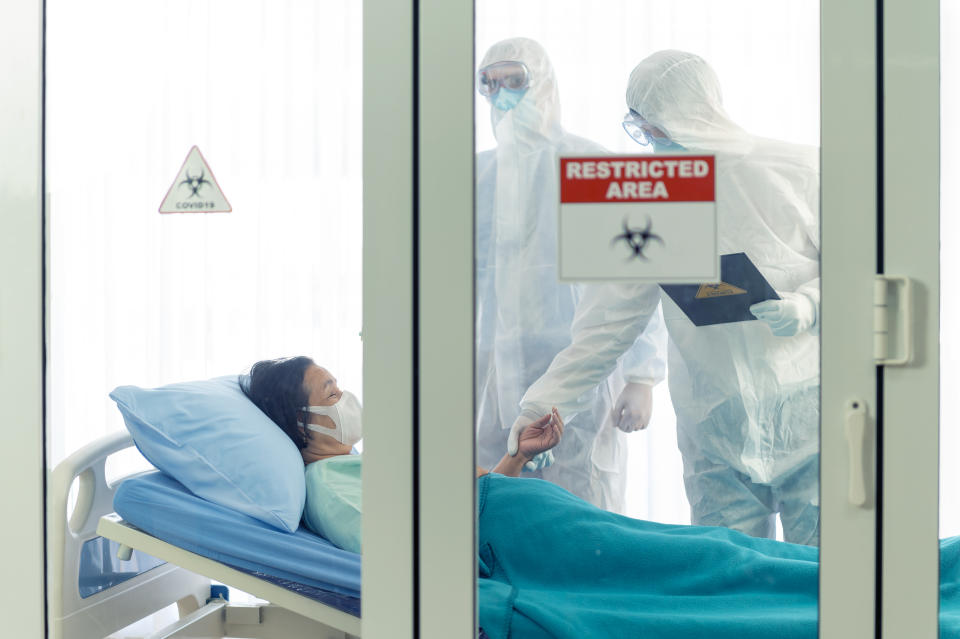Meet the health care heroes you've never heard of: Foreign-language interpreters, who are 'critical, now more than ever'

All across the country, people are calling out and paying tribute to “health care heroes” — medical workers on the frontlines of the coronavirus crisis who have been going above and beyond, putting themselves at risk to help save lives. But among the doctors and nurses and aides and technicians and hospital maintenance workers, there’s one vital group of health care professionals that can often go unnoticed: foreign-language interpreters. And now, especially, those who work remotely via video or phone.
“They are critical, now more than ever,” says Kristin Quinlan, CEO of Certified Languages International, a national interpreter company with more than 2,000 remote interpreters speaking a total of 233 languages. “Imagine you speak Korean and you go to the ER,” she says. “You’re terrified to begin with, but on top of that, you have no idea what they’re saying to you.”
A reported 20 percent of the U.S. population is in that position, she says, which adds up to many people being marginalized. “Our mission is to eliminate the barrier of language access,” says Quinlan. Her company is a part of a huge outsourced language industry, the global market for which reached $49.6 billion in 2019, according to a study by CSA Research. “I like to say it’s the biggest little industry nobody’s ever heard of — bigger than the global music industry,” Quinlan says, noting that about 65 percent of their interpreters work in the health care sector (along with a range of others, including insurance agencies, schools and Homeland Security).

“Any good doctor is only as good as how they are understood by the patient,” Natalya Mytareva, executive director of the Certification Commission for Healthcare Interpreters, one of the national certifying bodies for medical interpreters (including CLI), told Time recently. “If the doctor is basing the diagnosis on the wrong information because they didn’t have an interpreter, then what good is that doctor?”
Still, that article pointed out, the social distancing measures of the pandemic have been upending the in-person interpreter industry, with one solution being third-party companies, particularly those that are used to working remotely.
CLI, having always used all-remote technology, was able to seamlessly enter into the current situation. “And this is an incredibly crazy time,” Quinlan adds, “with roughly 30,000 calls a day.” The company has also seen a 70 percent increase in interpreters inquiring how to work for the company, according to Time.
Among the stable of CLI interpreters, the most in-demand have been those who speak Spanish, Vietnamese, Arabic, Somali, Russian and Chinese Mandarin, in that order — although the huge range of offered languages varies from Korean and Swahili and Cape Verdean Creole to Ukrainian and Malay and Gujarati. The way it works is that a hospital or other company will maintain an account with CLI, and then the doctor or other professional go-between will ring into the 24/7 on-demand system, request the language and be connected to the interpreter, for a call that’s billed by the minute.
Now, with the increased demand of the coronavirus pandemic, interpreters are facing an increased challenge when it comes to perfecting an interpreter’s already delicate balance — offering strict interpretation with a tone of compassion, without crossing the line into consoling.
“I found that during this [pandemic] it’s become much more important to deliver the information in a calm voice with a supportive tone, in a way that can sort of help bring comfort,” Helen Sweeney, a Russian CLI interpreter, tells Yahoo Life. “Because some are elderly, and they are terrified and alone.”
“As a medical interpreter,” she adds, “I often deal with the entire spectrum of human emotion within each day: from the exhilaration of childbirth to the relief of successful surgery to the sorrow in the passing of a loved one — and everything in between.” She’s also highly aware of the “huge responsibility” that comes with her job, noting, “A medical interpreter can truly make a difference in a life-or-death situation.”
Right now, says Sweeney, who is based in Arizona and was drawn to her field, in part, after seeing her husband struggle to understand doctors when he wound up in the hospital while on vacation years ago, all hospital patients are affected by the coronavirus, because of restricted visitor policies. “People who can normally have someone there for emotional support, for decision making, to explain things, they don’t have that. So, patients are alone, they’re scared, they’re uncertain, and on top of it all, you have the language barrier,” she says, adding that the element of crisis management has been pervasive.
“The majority of calls are becoming heavy in nature,” she says. “Just yesterday I had a hospital patient — she was 87, partially paralyzed and in quarantine, and she’s unable to have any visitors. She’s terrified, all alone, she was crying. It was hard to be able to really connect with her and help her know she’s not alone.”
Another client she’s worked with recently, Sweeney says, had come to the U.S. to visit his daughter, only to encounter major health issues and wind up in the hospital, where he’s been for two months, and where his daughter is not allowed to visit. “His visa is running out, he’s been struggling through major surgeries, and he’s difficult to understand because he has tubes all over,” Sweeney says. Luckily, she adds, he usually calls in for interpreter support at around the same time of day, during her shift. “I’ve been able to get him quite a bit at the same time ... so I’m becoming that familiar face for him. I feel like it’s more important more now than ever.”
Marisol Varela, a Spanish interpreter and CLI quality assurance specialist based in Oregon, says she’s been particularly grateful for the video technology, and that she’s found it to be an important tool for conveying nonverbal expressions as well. “I experienced a situation where the patient on the other end was a little bit confused about why they were deciding to intubate her ... and she didn’t say, ‘Wait, I’m confused,’ but you could tell from the tone of the conversation,” she says. Varela, who was drawn to this field after being an “interpreter” for her parents, immigrants from Mexico, in “all sorts of situations” while growing up, was able to convey that confusion, leading to a supportive comment from the doctor: “Don’t worry, we’re here for you.”
Such rewards are huge, say translators like Giancarlos, a Spanish interpreter (who asked that his last name not be used, for privacy), who recently dealt with an elderly woman, alone at the ER and unable to breathe.
“While she was trying to explain to the doctor her symptoms, she couldn’t stop crying. This woman was begging for help, and the doctors did an amazing job comforting her,” he tells Yahoo Life. “They included me as part of the team, and all of us together helped her. Right before the call ended, the woman only said, ‘Thank you, and God bless you, son’ ... the best reward we can receive from someone who is sick and desperate for help.”
And, as Varela notes, “there are stories of joy too,” particularly when interpreters get to communicate COVID-negative test results or hospital discharge instructions.
When Spanish interpreter Melody (who also requested her last name not be used) received a call recently, she says she hadn’t realized it was COVID-19-related until she told the patient he would be going home and he started crying. “He said, ‘Thank you, thank you, I can’t believe I’m going to see my daughters again. Thank you to you, doctor, to the hospital, thank you, medicine. You saved my life.’ And every time the doctor said something, he’d say, ‘Thank you, forever grateful’ or ‘Thank you a million times.’ It was the second call I got that day, and it brightened up my whole week!”
Such a positive experience is “really highlighted,” Varela says, “because you see the heaviness of everything — so a positive story stays with you.”
For the latest coronavirus news and updates, follow along at https://news.yahoo.com/coronavirus. According to experts, people over 60 and those who are immunocompromised continue to be the most at risk. If you have questions, please reference the CDC’s and WHO’s resource guides.
How to maintain your physical and mental health during the pandemic
Taking care of a loved one with COVID-19? Here’s how to stay healthy
Q&A with Dr. Kavita Patel: How to keep your family safe and maintain your mental health



